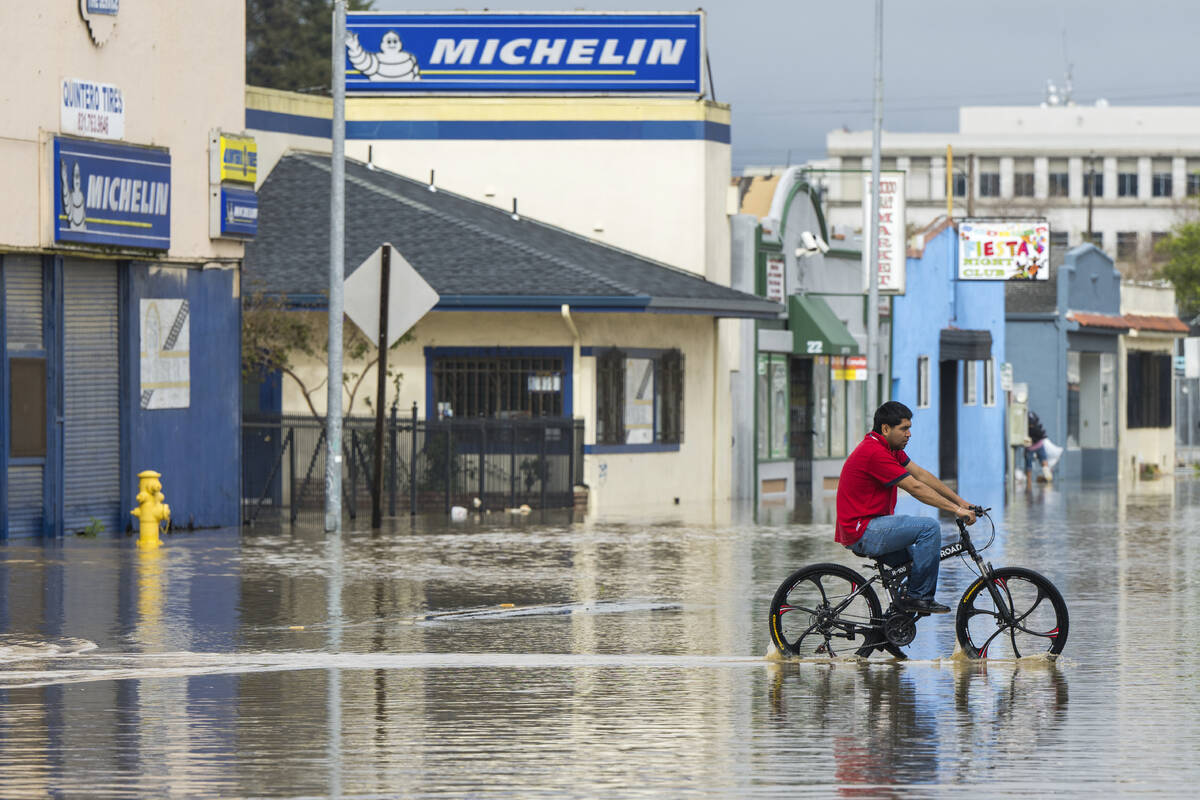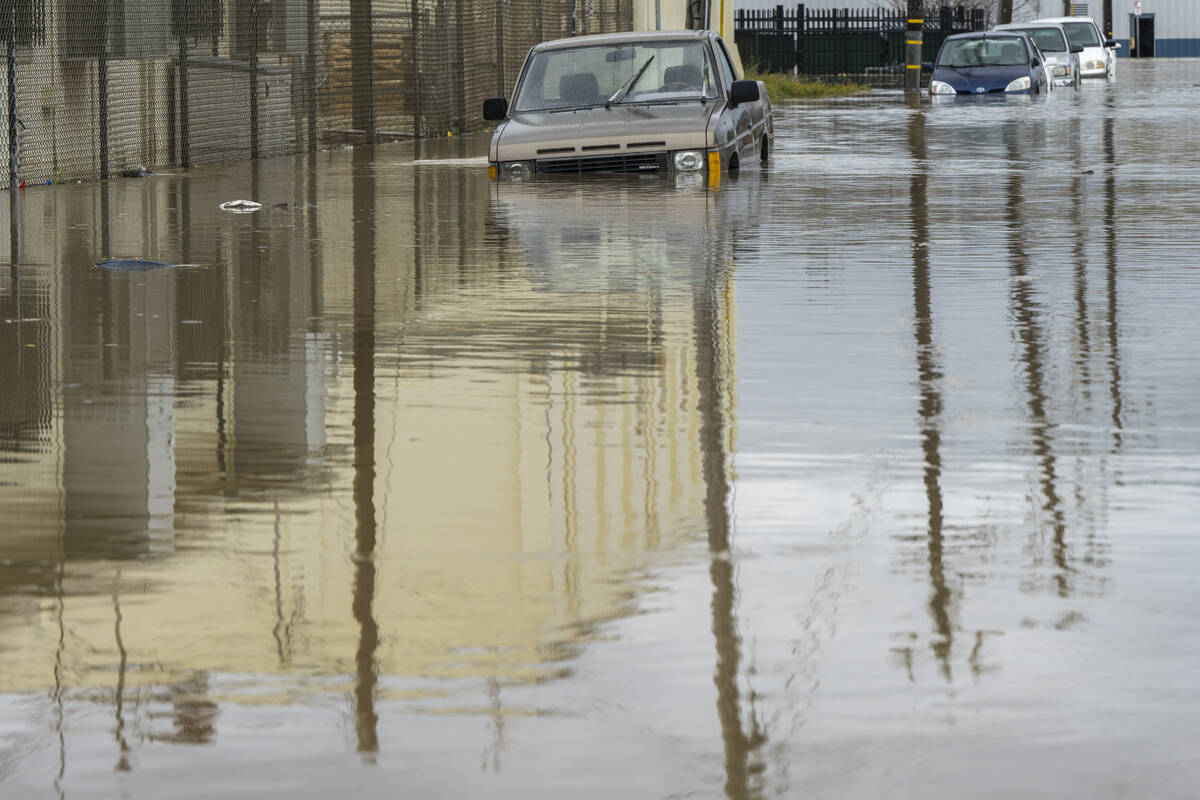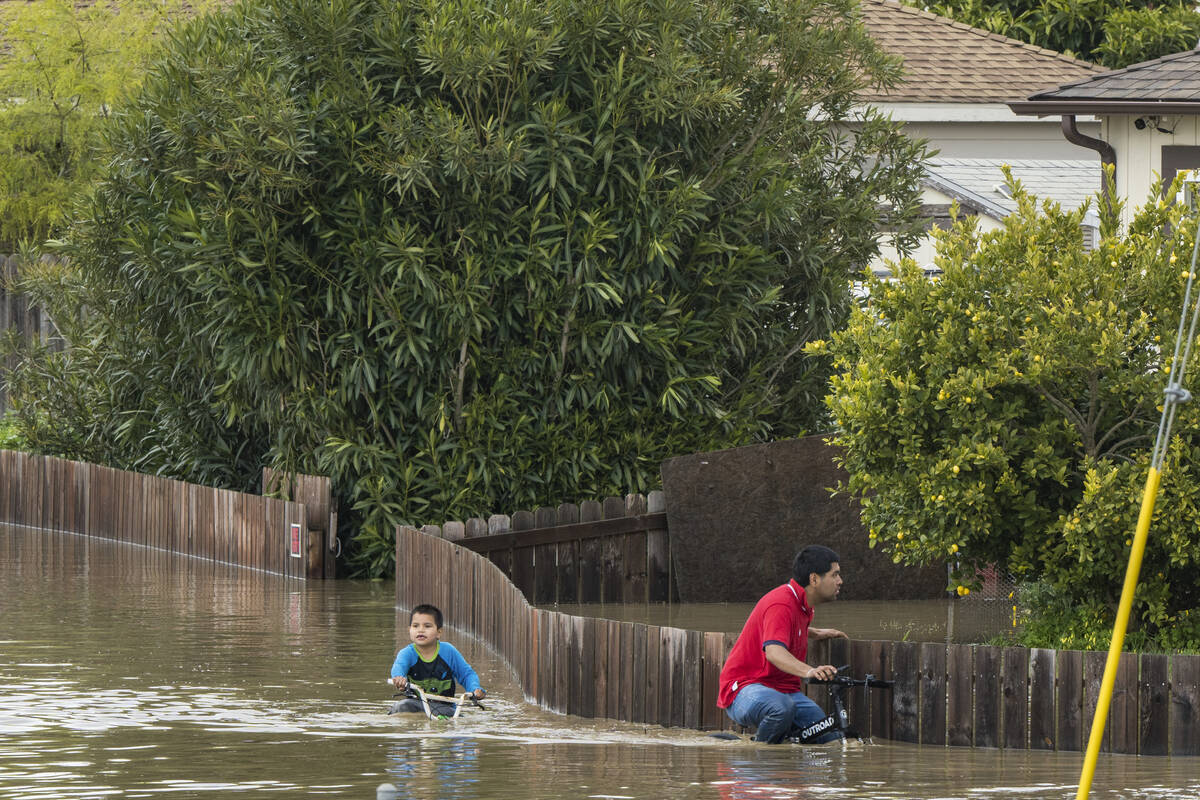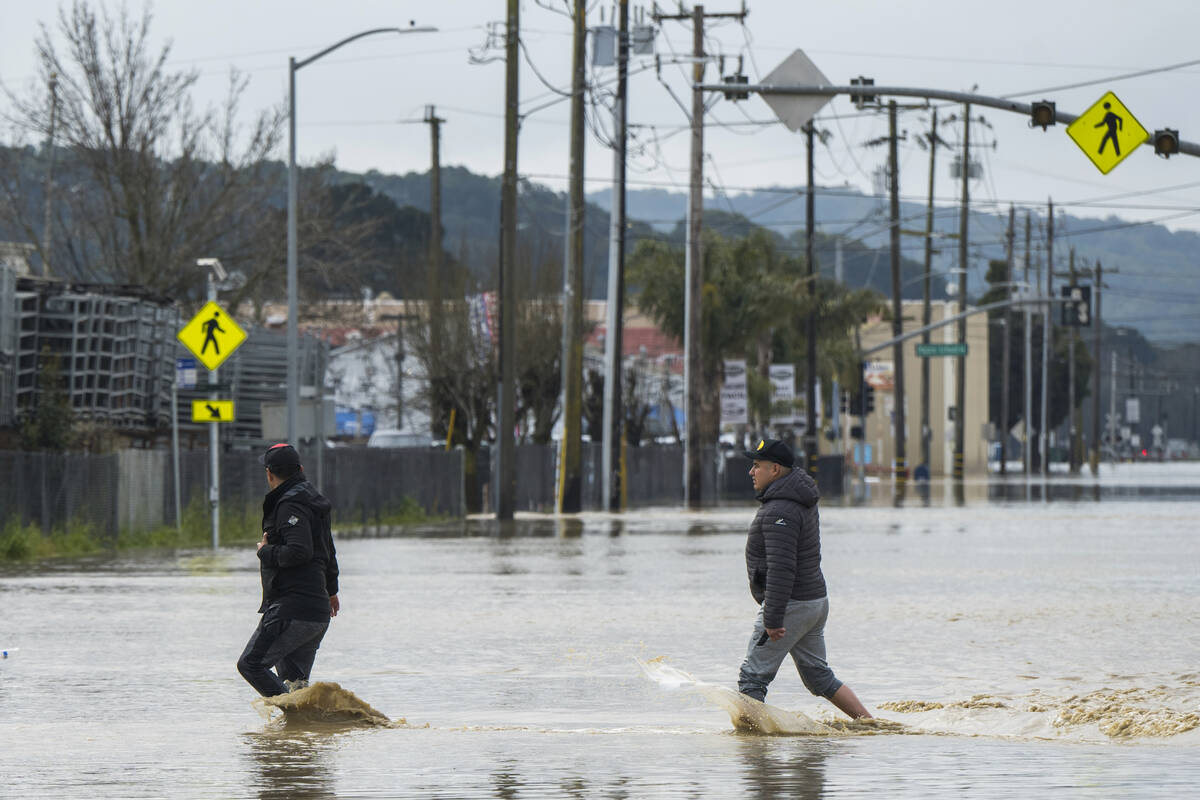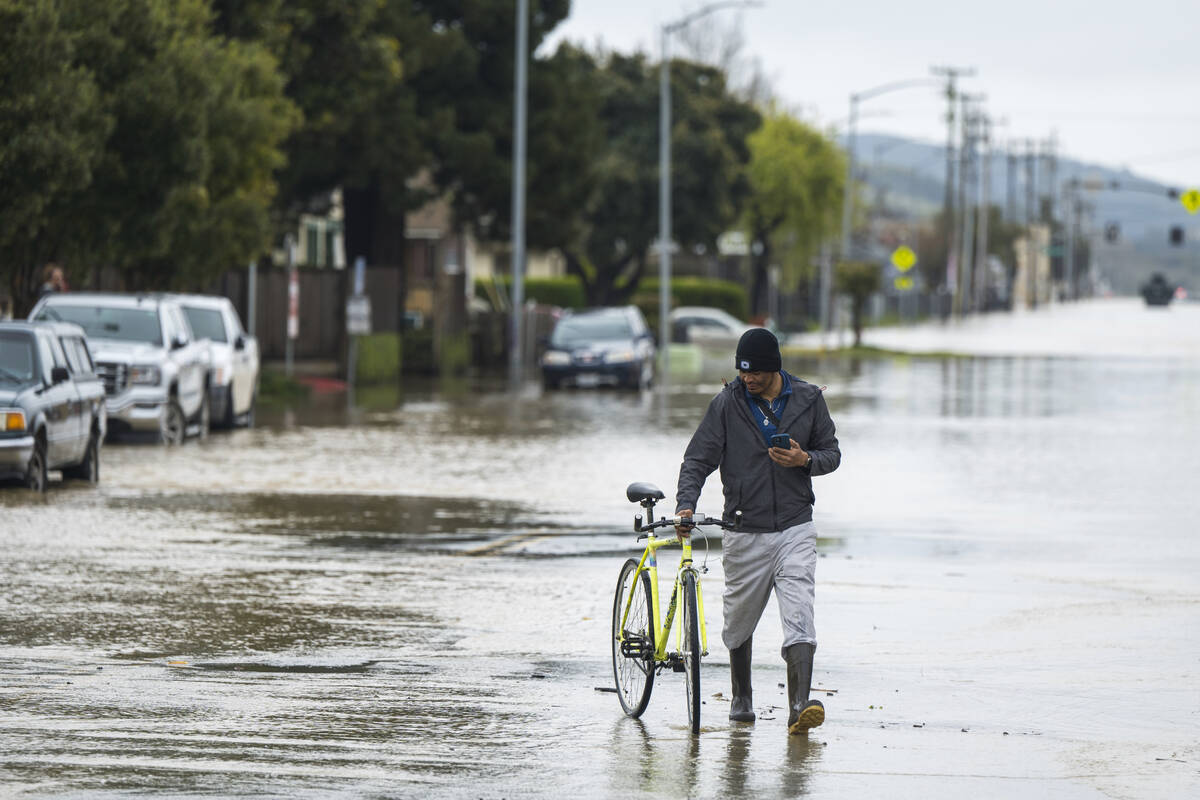Another atmospheric river awaits to hit California
WATSONVILLE, Calif. — Wet, miserable weather continued across huge swaths of California on Sunday as an atmospheric river that caused major flooding flowed eastward, and as a new system threatens the region with another onslaught of rain, snow and gusting winds as soon as Monday night.
The National Weather Service said the next torrent could exacerbate the severe flooding that overwhelmed the area in recent days, causing a levee failure that prompted widespread evacuations Saturday in farming communities near the state’s Central Coast.
The next system is not expected to bring as much rain, but forecasters cautioned that “considerable flooding” could occur in lower elevations from additional rain and snowmelt that could swell creeks and streams.
“Definitely prepare for some more flooding impacts. The ground is very saturated. We’re already seeing some impacts from some light amounts even today,” National Weather Service forecaster Eleanor Dhuyvetter said.
Wild winter: California towns flooded with more rain, snow. Some 9,000 residents under evacuation orders, flash flooding in Kernville. https://t.co/U3DInLHNWK @ap @foxweather #California #CaliforniaStorms #CaliforniaFloods #atmospheric_river #CAwx pic.twitter.com/nvD3uemZul
— Dan Behringer ✪ (@DanBehringer221) March 11, 2023
The rain and snow is expected to extend from Central California to Oregon, as well as northern Nevada. Gov. Joe Lombardo expanded an emergency weather declaration Saturday night to cover 11 of the state’s 17 counties.
Of particular concern are the expected strong winds. The weather service is predicting wind gusts of up to 50 mph (80 kph) in some places — which could potentially snap tree branches and damage power lines.
But the new storm is moving fast, meaning it won’t have time to dump as much rain.
Over the past two days, more than 20 inches (50 centimeters) of snow fell at a measuring station in the Sierra Nevada, and the new system is expected to pack even more. The snowpack is now nearly twice the average — the highest amount of snowfall in about four decades, according to UC Berkeley’s Central Sierra Snow Lab.
Storms filled California's Lake Oroville with more than 526 billion gallons of water—nearly half of its capacity—between 12/21 and 3/8, bringing it up 168 feet. Photos @CA_DWR pic.twitter.com/U4dSkbBYKf
— Carl Parker (@parkertwc) March 10, 2023
Snow helps drought
The snowpack stores much-needed water for a state seeking to emerge from a three-year drought.
As much as a foot (30 centimeters) of rain fell in the Big Sur area of the state over a two-day period, weather data.
Authorities suggest that residents have a plan in case further evacuations orders are issued.
Across Monterey County, more than 8,500 people were evacuated Saturday, including roughly 1,700 residents — many of them Latino farmworkers — from the unincorporated community of Pajaro.
“We are still in disaster response mode,” said Monterey County spokesman Nicholas Pasculli on Sunday. He said the county is staging high water rescue teams around the county and opening more shelters in anticipation of more flooding as the new storm rolls in.
The flooding has impacted drinking water facilities in Pajaro. Officials said residents should not drink tap water for cooking or drinking until further notice.
Pacific Coast Highway closed in some places
Highway 1, also known as the Pacific Coast Highway, is closed at several points along Big Sur as well as near Pajaro due to flooding.
Relentless... California is getting pummeled by multiple storms again. Huge snow build-up in the mountains with significant flooding unfolding across Central Cali and southern Sierra.
The moisture has come from Hawaii, a textbook Pineapple Express atmospheric river. pic.twitter.com/yb94d5ObTC
— Scott Duncan (@ScottDuncanWX) March 11, 2023
The atmospheric river, known as a “Pineapple Express” because it brought warm subtropical moisture across the Pacific from near Hawaii, was melting lower parts of the huge snowpack in California’s mountains.
Because of the massive flooding over the early weekend, more than 50 people had to be rescued by first responders and the California National Guard. One video showed a Guard member helping a driver out of a car trapped by water up to their waists.
The extent of property damages was still uncertain but Luis Alejo, chair of the Monterey County Board of Supervisors, sought help from the state and federal governments.
“The need will be great! Will take months for our residents to repair homes!” he wrote in a tweet Saturday.
34 emergencies declared
Gov. Gavin Newsom has declared emergencies in 34 counties in recent weeks, and the Biden administration approved a presidential disaster declaration for some on Friday morning, moving to expedite more federal assistance. President Joe Biden spoke with Newsom on Saturday to pledge federal support for California’s emergency response, the White House said.
Weather-related power outages affected more than 17,000 customers in Monterey County late Saturday, according to the Governor’s Office of Emergency Services. By late Sunday morning, about 7,000 were still without electricity.
The governor’s office said it was continuing to monitor the situation in Pajaro.
Levee a known risk
The Pajaro River separates the counties of Santa Cruz and Monterey. Officials had been working along the river’s levee system in the hopes of shoring it up when it was breached around midnight Friday into Saturday. Crews began working to fix the levee around daybreak Saturday as residents slept in evacuation centers.
Built in the late 40s to provide flood protection, the levee has been a known risk for decades with periodic signs of significant trouble. In the 1990s the levee was breached several times, prompting flooding that led to evacuations and disaster declarations. Emergency repairs to a section of the berm was undertaken in January. A $400 million rebuild is slated to begin in 2025.
This week’s storm marked the state’s 10th atmospheric river of the winter, storms that have brought enormous amounts of rain and snow to the state and helped lessen drought conditions that had dragged on for three years. State reservoirs that had dipped to strikingly low levels are now well above the average for this time of year, prompting state officials to release water from dams to assist with flood control and make room for even more rain.



